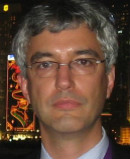主题演讲人
 Christophe Claramunt
Christophe Claramunt
Professor
Naval Academy Research Institute, France
Link:
http://christophe.claramunt.free.fr/
Speech Title: Maritime Environment and Information Systems: Current progress and research challenges
Abstract:The maritime environment provides many novel research challenges & application opportunities that still deserve to be addressed. In the maritime domain, the correlated computational exploitation of heterogeneous big data sources and streaming data is a crucial issue., while online tracking, early recognition of events, and anticipation of vessel trajectories are particularly crucial to safety and operations at sea. The objective of this talk is to review current research challenges and development directions tied to the integration, management, analysis, and visualization of objects moving at sea as well as a few computational solutions for a successful development of maritime forecasting and decision-support systems. The talk will focus on developments currently addressed by the EU funded H2020 datAcron project.
 Xiaxin Tao
Xiaxin Tao
Professor
School of Civil Engineering, Harbin Institute of Technology
Link:
http://homepage.hit.edu.cn/taoxinxia?lang=en
Speech Title: Preliminary result of a comprehensive cost - benefit analysis of the first PSHA map of China
Abstract:Seismic hazard map plays a important role in earthquake prevention and disaster reduction, since it is the basis for all kinds of engineering structures taking engineering measures and all cities/regions planning. The map issued in 1990 is the first national map prepared by the Probabilistic Seismic Hazard Assessment (PSHA) approach. It is now in debate internationally if the PSHA map could be tested, even it is obviously inappropriate to adopt the map as the basis of seismic fortification without any test. From the purpose of the map in disaster management, it is reasonable to evaluate the benefit of engineering seismic measures adopted from the map. To study a way to test PSHA map, a comprehensive cost - benefit analysis is presented in this paper for the case of the 1990 map of China. The map was updated in 2001, so the fortification cost is characterized by the additional cost of the most popular buildings with brick-concrete structure and frame structure constructed in all cities/regions of China during 1990 to 2001, that is calculated from the total amount of the two type buildings and the increasing rates of the corresponding fortification intensities of buildings in various regions during the period. The fortification benefit is characterized by the total economic loss and casualty caused by the damages of the buildings in earthquakes during 1990 to 2015 in all cities/regions of the whole country, comparing with the corresponding values estimated if no fortification measures were adopted. The preliminary result of this study shows a rough estimation that economic benefits of 1,819.4 billion RMB and a reduction of 283,260 deaths and 1,130,642 serious injuries was achieved from the implement of the PSHA map and the associated seismic design and construction, a considerable contribution to the country development indeed.
 Yurong Liu
Yurong Liu
Professor
Huazhong Agricultural University
Link:
http://zyhj.hzau.edu.cn/info/1016/2945.htm
Speech Title: Soil microbial communities control methylmercury accumulation and health risk
Abstract:Bioaccumulation of the neurotoxin methylmercury (MeHg) in rice has raised worldwide concerns due to its risks to human health. Certain microorganisms are able to degrade MeHg in pure cultures, but the roles and diversities of the microbial communities in MeHg degradation in rice paddy soils are unknown. Using a series of microcosms, we investigated MeHg degradation in paddy soils from Hunan, Guizhou, and Hubei provinces, representing three major rice production regions in China, and further characterized one of the soils from Hunan province for microbial communities associated with MeHg degradation. Microbial demethylation was observed in all three soils, demonstrated by significantly more MeHg degraded in the unsterilized soils than the sterilized controls. More demethylation occurred in water-saturated soils than unsaturated soils, but the addition of molybdate and bromoethanesulfonic acid as the respective inhibitors of sulfate reducing bacteria and methanogens showed insignificant effects on MeHg degradation. However, the addition of Cu enhanced MeHg degradation and the enrichment of Xanthomonadaceae in the unsaturated soil. 16S rRNA Illumina sequencing and metatranscriptomic analyses of the Hunan soil consistently revealed that Catenulisporaceae, Frankiaceae, Mycobacteriaceae, and Thermomonosporaceae were among the most likely microbial taxa in influencing MeHg degradation in the paddy soil, and they were confirmed by combined analyses of the co-occurrence network, random forest modeling, and linear discriminant analysis of effect size. Our results shed additional light onto the roles of microbial communities in MeHg degradation in paddy soils and its subsequent bioaccumulation in rice grains.
 Zhenhao XU
Zhenhao XU
Professor
Deputy Director, Urban Underground Space Engineering Department, Shandong University; Chair, Youth Group (Asia), Associated Research Centers for the Urban Underground Space
Link:
http://faculty.sdu.edu.cn/xuzhenhao/zh_CN/index.htm
Speech Title:A new simulation method for grouting of quick-setting slurry in tunneling and underground space development: the Sequential Diffusion and Solidification method (SDS method)
Abstract: Time-dependent viscosity characteristics of quick-setting slurry grouting lead to uneven distribution of viscosity in the slurry diffusion zone. At present, there still lacks reasonable and effective slurry-water interaction analysis method to reveal the diffusion behavior of quick-setting slurry in dynamic water of karst fractures and conduits. A Sequential Diffusion and Solidification (SDS) method was proposed, taking the spatial-temporal evolution of slurry viscosity into account. In addition, the validity and necessity of the SDS method were verified. Based on the SDS method, the slurry diffusion process under different flow velocities in a fracture was analyzed and the effects of flow velocities on the changes of the grouting pressure, the counter-flow diffusion distance, and the down-flow diffusion behavior were explored. The applicability and the feasibility of studying the slurry diffusion mechanism in a wide-open fracture on an engineering scale were determined. The SDS method is also applied to the numerical investigation of dynamic grouting and blocking of flowing water in karst conduits. It achieves the visualization of dynamic grouting in the conduit, and explores a reasonable and effective method for dynamic grouting via the flow control technology. The outlet flow, the loss rate of slurry, the distribution laws of velocity and pressure inside the conduit during plugging are furtherly analyzed. In addition, the mechanism of flow control on dynamic grouting and plugging of the large-flow conduits is revealed. Moreover, the results were applied to the large-scale water inrush control project of Hejing Limestone Mine, China. The SDS method can be used to simulate the dynamic water grouting process, providing an improved method for the simulation of permeation and compaction grouting.
 Chien-Yuan Chen
Chien-Yuan Chen
Professor and Chairman
Department of Civil and Water Resources Engineering, National Chiayi University
Link:
https://www.ncyu.edu.tw/civil_eng/content.aspx?site_content_sn=26836
Speech Title: Climate Change and Initiation of Slope-Land Disasters in Taiwan
Abstract: Worldwide, global climate change has caused numerous disasters. Further, it has influenced the local climate of Taiwan, marked by a continuous increase in temperature. In this study, local climate changes and slope-land disasters occurring in Taiwan were analyzed statistically. Rainfall data obtained from plain and river basin areas were separated for the analysis. Local climate change influenced rainfall distribution driven by climate events. Typhoon-induced rains caused relatively fewer slope-land disasters than did other climate events such as Meiyu front, tropical low pressure, and southwesterly flow events during 2017–2019. The fewer occurrences of typhoons in Taiwan caused a decrease in rainfall distributed in river basin areas and fewer slope-land disasters. Seismic disturbances observed after the Chi-Chi earthquake in 1999 and the subsequent typhoon-induced torrential rains were attributed to an increase in potential debris flow creeks; however, climate events caused by non-typhoon-induced slope-land disasters were more frequent than those caused by typhoon-induced slope-land disasters in recent years.
 Jie Ji
Jie Ji
Professor, Vice Director
State Key Laboratory of Fire Science, University of Science and Technology of China (USTC)
Link:
http://sklfs.ustc.edu.cn/2017/0727/c12630a189900/page.htm
Speech Title: Real-time forecasting of large-scale wildland fire spread based on data assimilation
Abstract:Ensemble transform Kalman filter (ETKF) is an extension of ensemble Kalman filter (EnKF), which avoids using "perturbed observations" to eliminate additional sampling errors. This paper demonstrates the capability of ETKF algorithm for sequentially correcting dynamically evolving fire perimeter positions at regular time intervals to enhance the prediction accuracy of wildfire spread. Forecast error covariance inflation scheme is adopted in the ETKF to address the underestimation problem of forecast error covariance of EnKF. Coupled to a widely-used fire spread simulator, FARSITE, the proposed approach is employed to a landscape with complex topography, where a fire barrier is also considered. The merits of ETKF algorithm for wildfire spread prediction are highlighted by simulation experiments using synthetically-generated observations. In order to quantitatively evaluate the prediction performance of ETKF, this paper has adopted a conservative index, Hausdorff distance, which is widely used in image processing area. This work is the first attempt of applying ETKF to wildfire spread simulation. The ETKF algorithm has been demonstrated to be more accurate than EnKF for a given ensemble size for wildfire spread simulation. The findings show that the ETKF-based data assimilation strategy is a promising tool for large-scale wildfire spread simulation.